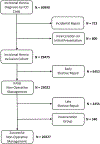The Risk of Incarceration During Nonoperative Management of Incisional Hernias: A Population-based Analysis of 30,998 Patients
- PMID: 32773624
- PMCID: PMC8917417
- DOI: 10.1097/SLA.0000000000003916
The Risk of Incarceration During Nonoperative Management of Incisional Hernias: A Population-based Analysis of 30,998 Patients
Abstract
Objective: The aim of the study was to quantify the risk of incarceration of incisional hernias.
Background: Operative repair is the definitive treatment for incisional ventral hernias but is often deferred if the perceived risk of elective operation is elevated secondary to comorbid conditions. The risk of incarceration during nonoperative management (NOM) factors into shared decision making by patient and surgeon; however, the incidence of acute incarceration remains largely unknown.
Methods: A retrospective analysis of adult patients with an International Classification of Diseases, Ninth Revision or Tenth Revision diagnosis of incisional hernia was conducted from 2010 to 2017 in 15 hospitals of a single healthcare system. The primary outcome was incarceration necessitating emergent operation. The secondary outcome was 30-, 90-, and 365-day mortality. Univariate and multivariate analyses were used to determine independent predictors of incarceration.
Results: Among 30,998 patients with an incisional hernia (mean age 58.1 ± 15.9 years; 52.7% female), 23,022 (78.1%) underwent NOM of whom 540 (2.3%) experienced incarceration, yielding a 1- and 5-year cumulative incidence of 1.24% and 2.59%, respectively. Independent variables associated with incarceration included: age older than 40 years, female sex, current smoker, body mass index 30 or greater, and a hernia-related inpatient admission. All-cause mortality rates at 30, 90, and 365 days were significantly higher in the incarceration group at 7.2%, 10%, and 14% versus 1.1%, 2.3%, and 5.3% in patients undergoing successful NOM, respectively.
Conclusions: Incarceration is an uncommon complication of NOM but is associated with a significant risk of death. Tailored decision making for elective repair and considering the aforementioned risk factors for incarceration provides an initial step toward mitigating the excess morbidity and mortality of an incarceration event.
Copyright © 2020 Wolters Kluwer Health, Inc. All rights reserved.
Conflict of interest statement
The authors report no conflicts of interest.
Figures



References
-
- Beadles CA, Meagher AD, Charles AG. Trends in emergent hernia repair in the United States. JAMA Surg. 2015;150:194–200. - PubMed
-
- Wolf LL, Scott JW, Zogg CK, et al. Predictors of emergency ventral hernia repair: targets to improve patient access and guide patient selection for elective repair. Surgery. 2016;160:1379–1391. - PubMed
-
- Bisgaard T, Kehlet H, Bay-Nielsen M, et al. A nationwide study on readmission, morbidity, and mortality after umbilical and epigastric hernia repair. Hernia. 2011;15:541–546. - PubMed
-
- Helgstrand F, Rosenberg J, Kehlet H, et al. Nationwide prospective study of outcomes after elective incisional hernia repair. J Am Coll Surg. 2013;216:217–228. - PubMed
MeSH terms
Grants and funding
LinkOut - more resources
Full Text Sources

